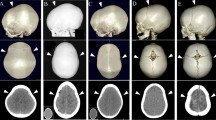Abstract
Scaphocephaly is the most common single suture craniosynostosis. Surgical technique has evolved from simple strip craniectomy over π-procedures and vertex craniectomies to extensive cranial remodeling which is preferred procedure nowadays. The purpose of this paper is to present our modification of Renier’s standard “H” technique and its preliminary results in detail. Eleven patients with scaphocephaly were surgically treated from January 2011 until January 2014. Only children with isolated sagittal synostosis were included in the study. Our modified Renier’s technique reduces the possibility of lesion of superior sagittal sinus, dividing parietal bone in three bone fragments, thus achieving shortening of the scull in AP diameter without detaching the bone from the superior sagittal sinus. The possibility for potential secondary stenosis is minimized using extended V-shaped osteotomies with rounding of the bone edges, as well as making wide neocoronal and neolambdoid sutures. Cosmetic results were estimated as very pleasing immediately after surgery by both the parents and the surgeons in all cases. The majority of patients presented in our study were categorized as Sloan Class 1. Improvement or normalization of the cranial index was accomplished in all patients. No revision surgeries were required during the follow-up. Triple square extended osteotomies technique is a fast, simple, and efficient surgical option for children with sagittal synostosis and can be safely applied in the first months of life in children even under weight of 6 kilos. Preliminary results are encouraging and deserve a longer follow-up and comparative surgical analysis to verify its usefulness in the future.









Similar content being viewed by others
References
Antúnez S, Arnaud E, Cruz A, Marchac D, Renier D (2009) Scaphocephaly: part I: indices for scaphocephalic frontal and occipital morphology evaluation: long-term results. J Craniofac Surg 20(Suppl 2):1837–42
Arnaud E, Capon-Degardin N, Michienzi J, Di Rocco F, Renier D (2009) Scaphocephaly part II: secondary coronal synostosis after scaphocephalic surgical correction. J Craniofac Surg 20(Suppl 2):1843–50
Arnaud E, Renier D, Marchac D (1995) Prognosis for mental function in scaphocephaly. J Neurosurg 83(3):476–9
Boran BO, Akgun C, Bozbuga M (2005) Calvarial remodeling for the treatment of scaphocephaly in a 4-month-old boy: case report. Turkish Neurosurgery 15(1):40–44
Di Rocco F, Ben Gbulie U, Meyer P, Arnaud E (2014) Current techniques and protocols in the surgical management of scaphocephaly in young infants. J Craniofac Surg 25(1):39–41
Di Rocco F, Knoll BI, Arnaud E, Blanot S, Meyer P, Cuttarree H, Sainte-Rose C, Marchac D (2012) Scaphocephaly correction with retrocoronal and prelambdoid craniotomies (Renier’s “H” technique). Childs Nerv Syst 28(9):1327–32
Drzymalski D, Proctor M (2011) Genetics of craniosynostosis. In: Winn HR (ed) Youmans neurological surgery. Saunders (Elsevier), Philadelphia, pp 1936–9
Epstein N, Epstein F, Newman G (1982) Total vertex craniectomy for the treatment of scaphocephaly. Childs Brain 9:309–16
Fearon JA, McLaughlin EB, Kolar JC (2006) Sagittal craniosynostosis: surgical outcomes and long-term growth. Plast Reconstr Surg 117(2):532–41
Fearon JA (2014) Evidence-based medicine: craniosynostosis. Plast Reconstr Surg 133(5):1261–75
Goodrich JT (2004) Craniofacial reconstruction for craniosynostosis. In: Goodrich JT, Staffenberg DS (eds) Plastic techniques in neurosurgery, 2nd edn. Theme, New York, pp 56–93
Goodrich JT (2014) Scaphocephaly. International Hands-on Workshop on Craniofacial Surgery. Acibadem University. Istanbul. 21 April. Lecture
In Vesalius Medical Image Software. http://svn.softwarepublico.gov.br/trac/invesalius
Ingraham FD, Matson DD (1954) Neurosurgery of infancy and childhood. Charles Thomas Publisher, Springfield
Jane JA, Edgerton MT, Futrell JW, Park TS (1978) Immediate correction of sagittal synostosis. J Neurosurg 49(5):705–10
Koh JL, Gries H (2007) Perioperative management of pediatric patients with craniosynostosis. Anesthesiol Clin 25(3):465–81
Mackenzie KA, Davis C, Yang A, MacFarlane MR (2009) Evolution of surgery for sagittal synostosis: the role of new technologies. J Craniofac Surg 20(1):129–33
Mehta VA, Bettegowda C, Jallo GI, Ahn ES (2010) The evolution of surgical management for craniosynostosis. Neurosurg Focus 29(6), E5
Melo JR, Portella Junior CS, Lelis LC (2013) Pires de Lima E. Scaphocephaly and cranial vault reconstruction: Renier’s ‘H’ technique. Pediatr Neurosurg 49(4):223–8
Sloan GM, Wells KC, Raffael CR, McComb JG (1997) Surgical treatment of craniosynostosis: outcome analysis of 250 consecutive patients. Pediatrics 100, E2
Author information
Authors and Affiliations
Corresponding author
Additional information
Comments
Concezio di Rocco, Hannover, Germany
Sagittal synostosis is the simplest and the most common form of craniosynostosis and also the one the management of which is the most variable from extensive cranial remodeling to simple strip craniectomies carried out with minimal invasive techniques or endoscopy. In the present article, the authors describe their personal variant, which is a modification of the widely utilized Renier’s technique. They aim at reducing the risk of bleeding from tearing of the small veins draining into the superior sagittal sinus or, in exceptional cases, from its direct laceration, associated with the removal of the overlying early fused suture. The relatively low blood losses the authors report in their preliminary series appears to confirm the safety of their procedure.
Although nearly all the techniques utilized in the correction of sagittal cranisynostosis may be considered to be effective in improving the cranial index and the cosmetic appearance of the affected child, it is still questionable whether they really achieve an equivalent correction of the presumed altered physio-pathogenetic mechanisms at the base of the malformation. Indeed, if we consider the constriction of the flow in the superior sagittal sinus eventually brought about by the abnormal ossification process of the overlying fused cranial suture one of the possible factor leading to a constant or intermittent increased intracranial pressure, then the technique here considered should be reserved only to those cases in whom the course of the superior sagittal sinus is unequivocally demonstrated to be free of any bone compression.
Rights and permissions
About this article
Cite this article
Micovic, M., Zivkovic, B., Bascarevic, V. et al. Triple square extended osteotomies for treatment of scaphocephaly (Renier’s “H” technique modification). Neurosurg Rev 39, 115–122 (2016). https://doi.org/10.1007/s10143-015-0661-z
Received:
Accepted:
Published:
Issue Date:
DOI: https://doi.org/10.1007/s10143-015-0661-z




